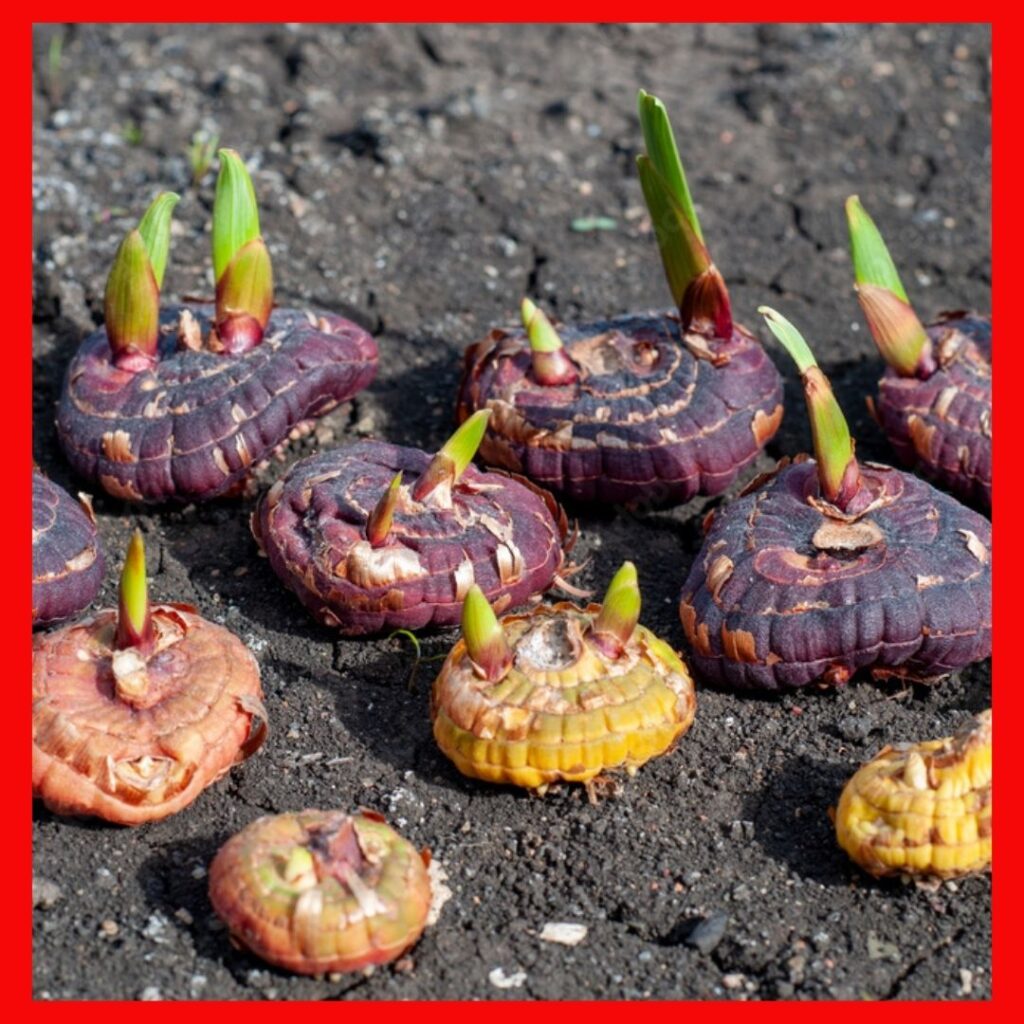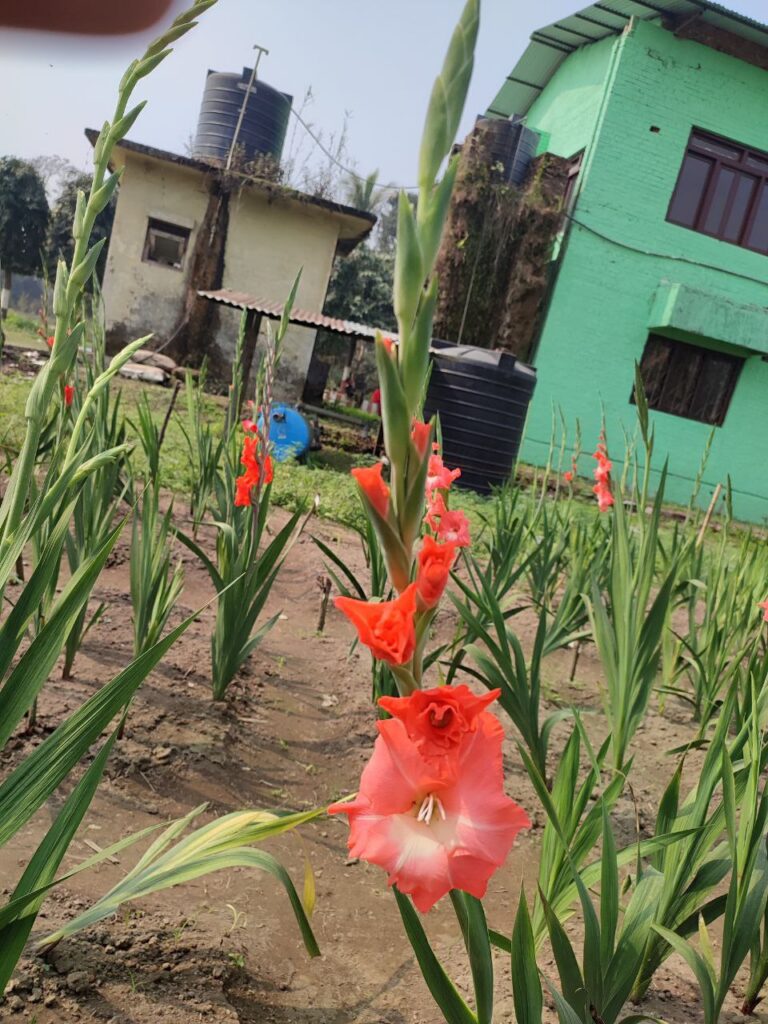Gladiolus is a tender, cormous, herbaceous ornamental plant, known for its tall flower spikes and large, colorful blooms, extensively used as a cut flower. Its name comes from the Latin word “Gladiolus,” meaning sword, due to its sword-shaped leaves, belonging to the family Iridaceae. Commonly referred to as the ‘Sword lily,’ ‘Queen of bulbous plants,’ or ‘Corn flag,’ the plant is believed to have originated in South Africa.

The flowering spike, which emerges from a bulb-like structure called a corm, can grow to a height of 60–90 cm (2–3 feet). It carries numerous funnel-shaped flowers arranged along one side of the stem, each consisting of six petal-like segments. The leaves are few and shaped like swords. Gladiolus is valued for its long-lasting flower spikes, which come in various sizes, shapes, textures, and colors to suit diverse preferences. Nearly every color is available, except for true green and black. The flowers primarily bloom between October and March.
Climate :
It is a major factor influencing the number of days to flower in gladiolus. Gladiolus is a winter annual that cannot tolerate frost below 6°C, as lower temperatures can cause chilling injury. Gladiolus thrives in temperatures ranging from 27 to 30°C and requires full sunlight. It performs best under long-day conditions with a photoperiod of 12 to 14 hours.
Soil :
Gladiolus grows best in well-drained sandy loam soil with a pH of 6 to 7. The soil should possess good water-holding capacity and be rich in organic matter.
Propagation :
Seed propagation:
Seed propagation is used for breeding purposes. Seeds are harvested after 4-5 weeks of flowering when the capsule turns brown. The seeds germinate in 2-3 weeks. It requires 3-4 years for flowering.
Corm/cormel/cormlet:
Commercially, corms larger than 2.5 cm in diameter are used to produce gladiolus flowers. Cormels or cormlets, which are 1–2.5 cm in diameter, are important for increasing the number of corms used for planting. The plants are harvested when the leaves begin to yellow and wither, and cormels form in clusters between the mother and daughter corms on short stolons.
After a dormancy period of 3–4 months, cormels are planted, with flowering occurring in the second or third year. There is a positive correlation between corm weight and spike production, with corms over 40 g producing higher-quality spikes compared to those weighing 30 g or less. Typically, corms have 6–15 buds, depending on their size, but only the apical bud sprouts to form the main stem and flower spike.

Division of Corms:
Large corms can be divided into smaller pieces for propagation, with each segment containing a bud and root zone to ensure growth.
Planting season :
October-November for plains and March-April for hills.
Land Preparation :
Soil preparation starts with deep ploughing to a depth of 30 cm before one or two months of planting. Flat beds are made for winter planting in Terai and raised beds for summer rainy season planting in hills. Application of FYM @ 20-25 tons/ha is mixed with soil. Ridges and furrows method of planting is adopted.
Spacing :
Depends upon the size of the planting material, purpose, and cultivars. In general for cut flower production; the spacing is 20 X 20 cm, 25 X 30 cm, 30 X 25 cm (ideal).
Planting and Planting Depth :
Planting of corms at 5-15 cm deep is practiced; the range depends on the physical condition of the soil, weather conditions, and planting material. Deep planting facilitates higher production of cormel and ensures vertical and straight growth, which prevents from lodging too.
Irrigation:
Regular irrigation at an interval of 7-10 days depending upon weather. Overwatering must be avoided. Irrigation should be stopped about 4 to 6 weeks before harvesting the corms.
Manuring and Fertilization :
Usually, FYM 20 tons & NPK @ 150:150:150 kg/ha is recommended for the soils with moderate amount of plant nutrition. Nitrogenous fertilizer splits 2-3 times. First split when 2-3 leaves develop, second split when spikes come out and the third split when spike maturity begins.
Intercultural operation:
Gladiolus needs earthing up; one at the 4th leaf stage (20 cm height) and the second when spikes merge.
Staking is also done to prevent the plants from lodging.
Mulching is also important to conserve soil moisture and reducing weed population.
To obtain a good yield, hand weeding is done. For appropriate control of weeds, 4-5 hand weddings are required.
Time and stage of harvesting :
Harvesting typically occurs 3 to 4 months after transplanting, specifically within 90 to 120 days. For distant markets, the ideal time for harvesting is when the first florets start to show color, while for local markets, it’s best to harvest when the first florets are fully open.
Harvesting should be carried out with two leaves using a sharp knife or secateurs, as the leaves supply substrates for floral metabolism. The optimal time for harvesting is in the morning when the cells are fully turgid. The cut spikes should be placed immediately in water indoors at temperatures of 6-7°C.

Corm and cormel harvesting :
Corms are ready for harvesting when 25% of the cormels have turned brown and the leaves begin to yellow, typically 6-8 weeks after flower harvesting. It is important to stop irrigating the field 2-3 weeks before harvesting. Since they are weak geophytes, extra care is needed during this process. Cormels are gathered by gently pulling the plant after loosening the surrounding soil.
The corms and cormels are kept in a shady, well-ventilated area for around two weeks. They need to be cured at a temperature of 21°C. The corms are cleaned and treated with 0.3% copper fungicide or Bavistin (0.1%) for half an hour. After treating they are dried in shade for 2-3 weeks. Once dried they are stored in plastic bags in cold storage at a temperature of 4°C.
